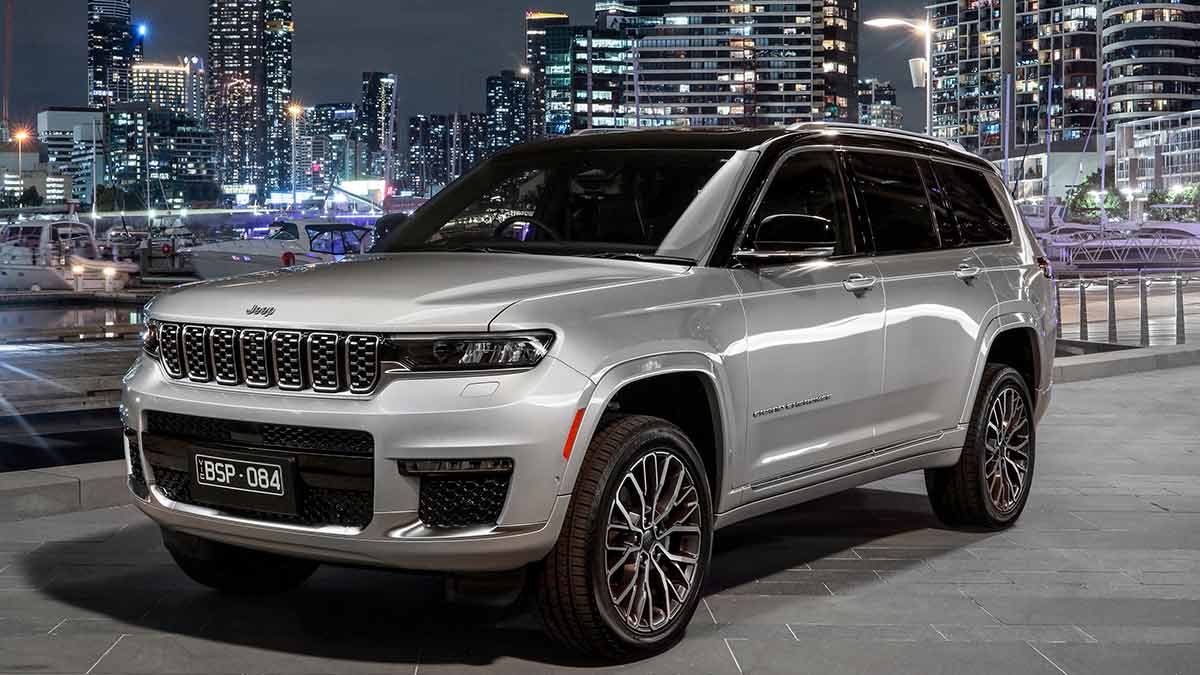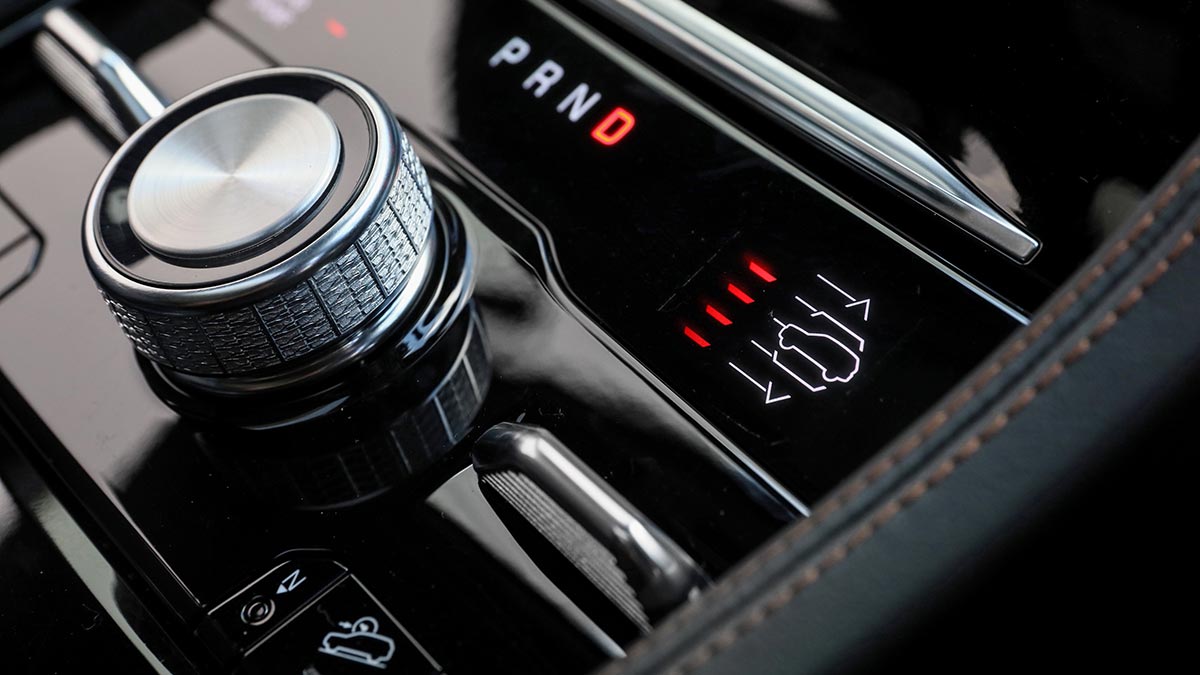The ninth-generation Toyota HiLux has arrived, bringing with it a futuristic forward exterior design, more safety and tech and the same rugged capability owners love. Will the updates tempt private buyers away from the Ford Ranger or are they just enough to keep fleets onside?
Jeep pulls the grandeur card with 2022 Grand Cherokee L

Towing capacity is down and occupancy is up as Jeep’s newest vehicle takes on the Toyota LandCruiser and Nissan Patrol for a slice of the off-road seven-seat SUV market.
Jeep has redefined the Grand Cherokee to compete with the seven-seater set in the large SUV segment.
It’s an arena the North American marque hasn’t paid attention to in Australia in recent years, focusing instead on its capable five-seat version with up to 3500kg towing capacity.
With the WL model Grand Cherokee L (as in long) arriving in showrooms from next month, the towing capacity ranges from 2,813kg to 2,268kg.
The company justifies the shift by saying more than 70 per cent of large SUVs sales are seven-seaters. So is it a case of robbing Peter to pay Paul?
Jeep Australia boss Kevin Flynn says the shift reflects the realities of the market: more people want seven seats and diesel is increasingly on the nose globally, despite the fact the current (WK) diesel accounted for more than half of Grand Cherokee sales in Australia.
“I’m not sure everybody tows to the capacity that (the WK) was offering,” Kevin said.
“And I think that one of the interesting things moving forward is actually what is the level that is actually needed as opposed to desired?”
It’s a valid point but one likely to be lost on many Australian buyers who still insist on purchasing off-road vehicles they’ll never use to their full capability.
For the record, the five-seat Grand Cherokee will arrive later this year and a petrol-electric plug-in hybrid should also find its way into showrooms in the near future.
On this page
- How much does the Jeep Grand Cherokee L cost?
- Is the Jeep Grand Cherokee L safe?
- What's the Jeep Grand Cherokee L like inside?
- What's under the Jeep Grand Cherokee L's bonnet?
- Is the Jeep Grand Cherokee L efficient?
- How does the Jeep Grand Cherokee L drive?
- Should I buy one?
How much does the Jeep Grand Cherokee L cost?
The entry level Night Eagle will start from $82,250 before on-road costs, rising to $87,950 for the Limited variant and $115,450 for the Summit Reserve.
That’s right: $115,450 for a Jeep equipped with a 3.6-litre petrol engine and eight-speed automatic.
Given the oenophiliac-related name, you’d be expecting a sophisticated vintage. The price is $20K dearer than a top-spec Nissan Patrol equipped with a 5.7-litre petrol engine and places the Grand Cherokee L midway into the diesel-powered Landcruiser 300 line-up.
Toss a couple of options at the top Grand Cherokee L (white is the only standard colour and “premium” paint is $1750, while an advanced tech pack bundling a head-up display, wireless phone charging, a night-vision feature and interactive passenger display costs $5500) and we’re talking around $130,000 on the road.
Just as the price and the absence of a diesel marks a massive shift in Jeep’s approach, so does the interior, which is now aiming for premium levels of equipment and materials.
Servicing intervals are 12 months and/or 12,000km and the first five visits to the dealership will cost $399. The warranty period covers five years or 100,000km.
Is the Jeep Grand Cherokee L safe?
The jury is officially still out on the new Jeep, with the seven-seater yet to be assessed by ANCAP and EuroNCAP.
Given the push into premium territory, it’s safe to assume Jeep has engineered the SUV to earn a five-star score.
Standard equipment includes autonomous emergency braking with cross-traffic, pedestrian and cyclist detection, active lane-keep, blind-spot monitoring, drowsy driver detection, traffic sign recognition and adaptive cruise control.
The Summit Reserve adds a surround-view monitor, semi-automated parking and an integrated off-road camera.
What’s the Jeep Grand Cherokee L like inside?
The push upmarket is reflected in the choice of quality materials throughout the cabin.
All versions have powered and heated front seats, a powered tailgate, a 10.25-inch digital driver’s display and 12 USB ports (six regular USB, six USB-C).
The infotainment touchscreen on the Night Eagle is 8.4-inches, expanding to 10.1-inches on the Limited and Summit Reserve.
The Limited adds ventilation to the front-row seats, heats the second-row pews and includes a terrain-selection mode, leather-trimmed seats, ambient interior lighting, auto high-beam headlamps and increases the speaker count from six to nine.
Buy the Summit Reserve and the gear extends to quilted leather upholstery, floor mats, a dual-pane panoramic sunroof, McIntosh sound system with 19 speakers, and open-pore walnut veneer on the dash and doors.
The front seats pick up a massage function and the climate control is four-way rather than three in the lower-spec vehicles.
Lift the tailgate and switches on the side will automatically lower the third-row seats, extending cargo capacity from 587 litres to 1328 litres.
And the Grand Cherokee can actually accommodate seven adults. The grandparents may not appreciate the minor contortions needed to access the third row but but once ensconced there, they’ll have no complaints in terms of head and legroom or visibility.
What’s under the Jeep Grand Cherokee L’s bonnet?
The venerable 3.6-litre “Pentastar” petrol engine is used across the Grand Cherokee L range.
In this guise it is producing 210kW and 344Nm. That’s more than enough for regular duties, with an anticipated 100km/h sprint time of just on eight seconds. Not bad for a vehicle with 2.2-tonnes of mass.
How it will cope with a load close to its maximum tow rating remains to be seen. The diesel engine found in the WK Grand Cherokee enjoyed a huge edge on torque, with 570Nm on tap.
Buyers wanting this level of output will have to wait for the plug-in hybrid. The turbocharged 2.0-litre four-cylinder engine is rated at 200kW and 400Nm. Combined outputs from the engine and electric motor are 280kW/637Nm, at least for around 45km while the 17kWh battery is being discharged.
Is the Jeep Grand Cherokee L efficient?
The tare mass of the Limited is 2190kg, while the Summit Reserve is 2270kg. Hauling those weights is going to tax any engine and the 3.6-litre petrol uses a claimed 10.6 litres/100km on the combined test cycle.
Cruise around town and the figure climbs to 13.9 litres/100km, meaning it’s a good thing the Grand Cherokee L has a 104-litre tank.
How does the Jeep Grand Cherokee L drive?
The L is a vehicular leviathan at 5204mm in length. The impressive part isn’t the number itself (longer than a Patrol or a LandCruiser), but the fact the only time owners will really notice is when they’re by necessity occupying two spaces in a shopping centre car park.
An 11.7-metre turning circle isn’t too onerous around town and the sharp steering means turning into corners is a precise exercise.
Potential buyers will have to splurge on the Summit Reserve to get a low-range transfer case and air suspension with adaptive dampers. The low-range enables a crawl speed that the hill descent control will happily set as low as 1km/h, which is a boon when tackling big rock obstacles.
Meanwhile the suspension tweaks enhance the Grand Cherokee L’s ability in all circumstances. It can be raised for rutted tracks, improving ground clearance and approach/departure angles, or lowered at highway speed to trim the centre of gravity and minimise body roll.
The default ground clearance for all Grand Cherokees is 215mm, which is 20mm lower than the Toyota LC300.
Freeway driving is relaxed and external noise struggles to be heard in the cabin. It’s not quite at European levels but it is enviably close.
The Night Eagle and Limited roll on 20-inch alloy wheels; the Summit Reserve rides on 21s.
Should I buy one?
The Grand Cherokee L is a massive step up in interior amenity, while still endowed with enough off-road credibility to satisfy big families who like to go bush.
It is not going to challenge a Wrangler or Gladiator as the ultimate off-roader but it is going to be a contender for all-round duties.
Buyers who plan to tow a 7.3m (24-foot) caravan, will probably look elsewhere. Jeep Australia reasons there aren’t that many of them, compared to prospective owners with a need for seven seats.
The as-yet unknown variable will be whether Jeep plans to install the twin-turbo six-cylinder petrol engine it has just developed to replace the 5.7-litre Hemi V8.
If it does, that will give the company access to both buying groups, though the cost will inevitably increase.
The information provided is general advice only. Before making any decisions please consider your own circumstances and the Product Disclosure Statement and Target Market Determinations. For copies, visit racv.com.au. As distributor, RACV Insurance Services Pty Ltd AFS Licence No. 230039 receives commission for each policy sold or renewed. Product(s) issued by Insurance Manufacturers of Australia ABN 93 004 208 084 AFS Licence No. 227678.












